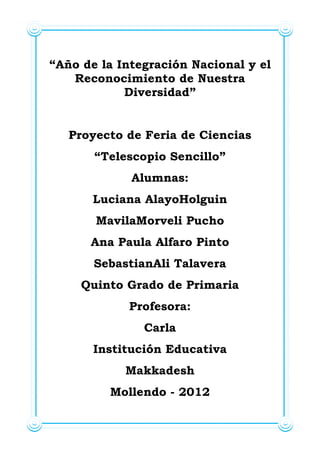
Feria e ciencias
- 1. “Año de la Integración Nacional y el Reconocimiento de Nuestra Diversidad” Proyecto de Feria de Ciencias “Telescopio Sencillo” Alumnas: Luciana AlayoHolguin MavilaMorveli Pucho Ana Paula Alfaro Pinto SebastianAli Talavera Quinto Grado de Primaria Profesora: Carla Institución Educativa Makkadesh Mollendo - 2012
- 2. TELESCOPIO SENCILLO /// / / | | | | | | / (( ( | | | | / .............| |...............| |...0 | | | | // | | / / | | / / / (__== ) ) (__ __/ ( ( COMO SE HACE UN TELESCOPIO Hacer un telescopio dentro de un tubo es más complicado de lo necesario. Los telescopios con un tubo que se desliza dentro de otro es útil, pero difícil de construir. Esta es una versión muy simple, todo lo que necesitas es un par de lupas. LOS LENTES Necesitamos dos lentes para construir un telescopio, al más grande se le llama "objetivo" y al pequeño "ocular" / | | | | / (( ( | | | | / .............| |...............| |...0 | | | | // | | / | | | / / LENTE LENTE OBJETIVO: OCULAR: Grande pequeño convexo poderoso casi plano convexo o cóncavo
- 3. El lente objetivo debe ser siempre un lente convexo. Estos lentes son más gruesos al medio y se pueden usar como lupas. Trata de encontrar uno que sea grande y un poco plano. Cuanto más plano sea, más poderoso será tu telescopio, cuanto más grueso sea en el centro más débil será tu telescopio. _______ _-- --_ <_ _> Vista de costado de un lente convexo --_______-- ___----___ _/ _ /______________ Este tipo (plano convexo) también funciona El lente ocular puede ser convexo o cóncavo. Si usas un lente convexo el telescopio hará que las imágenes se paren de cabeza. Si usas un lente cóncavo, tu telescopio no hará que las imágenes se vean de cabeza. Este tipo de telescopio se llama "Galileano" Para tu ocular trata de encontrar u lente que sea pequeño y poderoso. Las lupas pequeñas pueden ser buenas para esto. |_ _/| | ---_____--- | | _____ | Lente cóncavo poderoso | _--- ---_ | |/ | _ _ | ---_______--- | | _______ | Lente cóncavo debil |_--- ---_| USANDO EL TELESCOPIO La punta a un objeto distante, tales como árboles. Sostén el lente ocular (pequeño) cerca a tu ojo y observa através de éste. Sostén el lente objetivo (grande) en frente del lente ocular. Mueve lentamente el lente grande hacia adelante, hasta que la imagen se vea claramente, es un poco difícil hallar la distancia adecuada. Tus lentes son ahora un telescopio! Puedes usar dos lentes de lupa, una lupa grande y otra pequeña, sin embargo notarás que las imágenes tienen un halo de colores alrededor. Esto se debe a que la lupa grande (el objetivo) funciona como un prisma. Este efecto se llama "aberración cromática".
